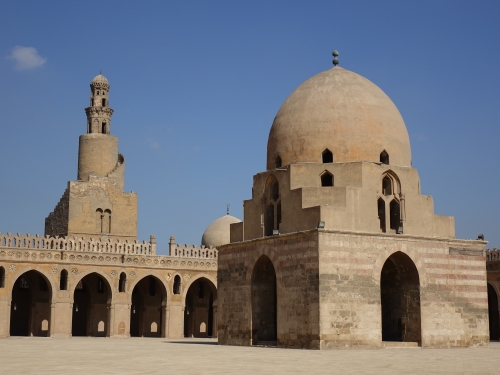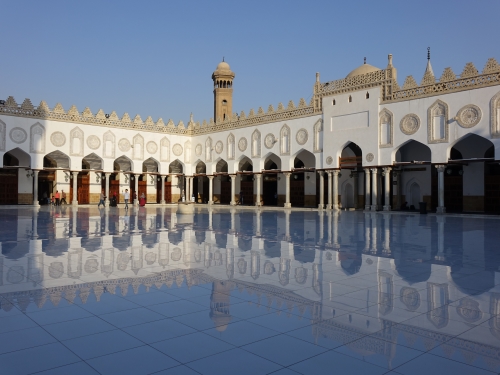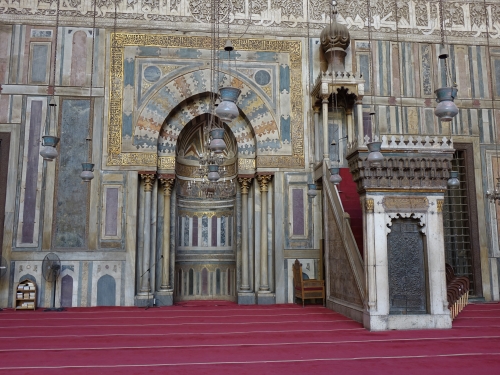Blog WHS Visits
WHS #687: Historic Cairo
A lot can be said about Historic Cairo and Cairo in general, but I will focus my review on the mosques of Islamic Cairo. I was in the mood for it: just before this trip I bought the book Mosques. Splendors of Islam and I recently re-visited Istanbul – famous for its exquisite Ottoman mosques - as well. Cairo however might the best place in the world to see the architectural development of mosques: from the Samarran style to the designs favoured by the Fatimids, the Mamluks and the Ottomans.

Beforehand I had made a list of mosques from the different periods that I wanted to see: Ibn Tulun Mosque (Samarran) + Al Hakim & Al Azhar Mosque (Fatimid) + Sultan Hassan & Aqsunqur Mosques (Mamluk) + Muhammad Ali Pasha (Ottoman). Due to the considerable walking distances between them, I ended up only visiting the ones that I have underlined.
The first of these was the oldest: the Mosque of Ibn Tulun (879). It exemplifies the early tradition of the Arab-plan or hypostyle (“many columns”) mosque, with a spacious courtyard (“to accommodate the large number of worshippers during Friday prayers .. in the warm Middle Eastern and Mediterranean climates”) and a flat roof dominated by a single minaret. From downtown I first rode 2 stops southwards by metro to Saad Zaghloul station and then - with a map in hand – looked out for this mosque. I immediately walked in the right direction, but it still took me 20 minutes to find it. Nothing is signposted here in Cairo and the mosque is too low to stand out among the surrounding buildings (you can see it very well though from the Citadel looking down).
The Ibn Tulun mosque is known for its spiral-shaped minaret, which has been designed following the example of the minaret of the Samarra Mosque in Iraq. The mosque does not look very much in use anymore: much of it is covered in pigeon droppings. At the entrance you get protective covers for your shoes - probably intended not to contaminate the holy ground with street dirt, but here also very welcome as a hygiene measure. Nevertheless, I was very impressed by its simple but strong architecture.

From the 10th century on, the Fatimid Dynasty came into power in Cairo and the city started rivalling Istanbul. The change the Fatimids brought with them was the veneration of their caliph. This lead to public appearances in the form of holy processions and in mosque architecture the innovation of the mosque façade as an important backdrop for sacred rituals. The Al Azhar mosque is one of the buildings left from the Fatimid heritage in Cairo. It was still built as a hypostyle mosque: I found many students praying and reading under the shaded corridor, while the marble of the open courtyard was being polished and cleaned to perfection. I arrived during prayer time, but that did not matter: I was welcomed anywhere on the premises (after they had given me a robe to wear). This was also the most actively religious of the mosques that I entered on this day. I encountered many Muslims from other countries such as Malaysia / Indonesia and Central Asia praying and probably studying here (it is said to be the oldest still operating university in the world).
In the 13th century, the Mamluks took over Cairo. They were equally ambitious builders as the Fatimids. Their innovations included the integration of charitable institutions and mausolea into their mosque designs. They are also known for their intricate stone masonry. And they replaced the hypostyle structure of the prayer hall with the Persian iwan (with 4 open spaces, 1 on each side of the courtyard). From this period I visited the Sultan Hassan mosque. This huge mosque lies at the foot of the Citadel. Its portal and courtyard, in the textbook Persian iwan style, are just beautiful. Behind the pulpit lies another room, intended for the tomb of Sultan Hassan himself (but that never happened). Here too, one gets the feeling of being in Persia. The corners of the burial room are covered with muqarnas.

Finally, the Muhammad Ali Pasha mosque at the Citadel is a pure Ottoman creation. It was modelled after the Yeni Valide Mosque in Istanbul (according to wikipedia its model was the Sultan Ahmed Mosque – but I think it looks more like the Yeni, a suggested by the Mosques. Splendors of Islam book). This is the most visited mosque of Cairo and just as the rest of the Citadel a bit too touristy for my taste.
There are many beautiful, really old buildings to see here in Historic Cairo: you just have to look through the mess. Cairo does not have the grandeur of Istanbul, but it has much more variety in building styles. A full day is necessary already for Islamic Cairo alone: I walked around from half past 8 to half past 4. And then you still have Coptic Cairo left which is also part of this WHS and worth half a day.
Els - 10 November 2018